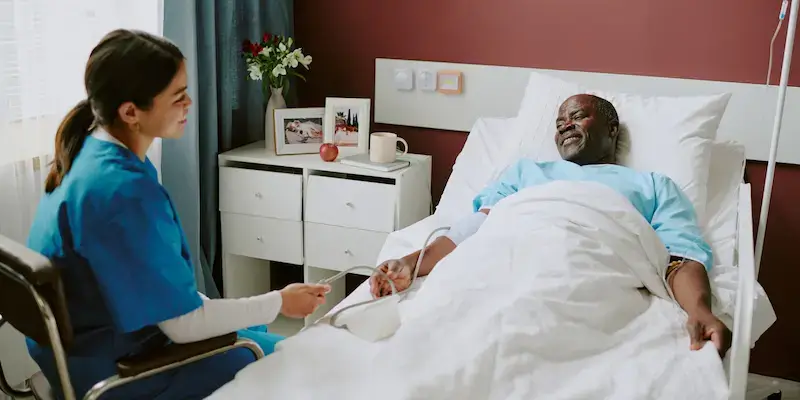Home >
The Rafaelo procedure
Get rapid access to our leading specialists.
The Rafaelo procedure (Radio Frequency Ablation of Haemorrhoids under Local Anaesthetic) is a surgical procedure used to treat internal haemorrhoids using radiofrequency ablation, a technique that is well established in the treatment of varicose veins.
Learn more about Rafaelo procedures at King Edward VII’s Hospital
Why would I need the Rafaelo procedure?
If you have internal haemorrhoids that are causing you pain, discomfort or bleeding, the Rafaelo procedure can provide relief from your symptoms.
What symptoms does the Rafaelo procedure address?
This procedure can help to treat the bleeding, discharge, itching and discomfort caused by internal haemorrhoids that have been graded between 1 and 3. Your specialist will tell you what grade your haemorrhoids are. If they’re a larger, more advanced grade 4 or mostly external (outside the anal canal), the Rafaelo procedure may not be suitable.
When should you speak to your specialist about the Rafaelo procedure?
If you have haemorrhoids that are causing you discomfort, speak to your specialist who can take a look at your back passage, assess you for treatment and can discuss your treatment options with you.
How is the Rafaelo procedure performed?
The Rafaelo procedure is carried out under local anaesthetic, sometimes also with sedation. You’ll be awake throughout the procedure, but if you have a sedation, you will feel sleepy and relaxed. Some patients choose to have the procedure under general anaesthetic. Either way, you’ll be able to return home the same day.
You will be asked to lay on your left hand side with your knees pulled up towards your chest. Your doctor will then insert a tube called a proctoscope into your anus. The proctoscope has a light on the end that allows your doctor to have a clear view of your haemorrhoids.
Your doctor will then inject a small amount of local anaesthetic under the haemorrhoid and deliver radiofrequency energy to the haemorrhoids using a special needle probe. Radiofrequency ablation uses heat to coagulate both the blood vessels supplying the haemorrhoids and the haemorrhoidal tissue. The haemorrhoids then reduce in size. The process of shrinkage continues in the two weeks after the radiofrequency energy has been applied.
The Rafaelo procedure takes around 15 to 20 minutes.
What is the recovery like for the Rafaelo procedure?
The Rafaelo procedure has been developed to be relatively pain free compared with other haemorrhoidal treatments. Most patients are able to return to their normal duties the following day. You may need to take simple painkillers such as paracetamol and ibuprofen for two days after the procedure. Some people experience urgency for two days after the procedure, where they feel an urgent need to open their bowels but find that they can’t produce a stool when they visit the loo. The urgency is caused by stimulation of the sensory nerves in the back passage by the radiofrequency energy and settles spontaneously.
Are there any risks/complications associated with the Rafaelo procedure?
As with any medical procedure, it’s possible for risks or complications to arise. Speaking with your specialist or surgeon beforehand will help you avoid any adverse reactions.
The Rafaelo procedure has a very low risk of serious complications, but the following events can occur in a small number of cases:
- Bleeding
- Infection
A small amount of bleeding each time you open your bowels in the first two weeks after the procedure is normal. If you experience bleeding of more than a cupful (200 ml) in 24 hours, you should seek urgent medical attention.
How can I prepare for the Rafaelo procedure?
Prior to the Rafaelo procedure, your surgeon will discuss with you how best to prepare for it, as each patient is different.
Common preparations for the Rafaelo procedure include:
- Routine blood tests, x rays or scans as requested by your surgeon
- Taking steps to stop smoking if you smoke
- Losing weight if you’re overweight
- Remaining active and doing regular exercise
Are there alternatives for the Rafaelo procedure?
There are various treatments available for haemorrhoids, depending on their size, position within the anal canal and severity. These include rubber band ligation, the THD (Transanal Haemorrhoidal Dearterialization) procedure, the HAL (Haemorrhoidal Artery Ligation) operation and haemorrhoidectomy (surgery to remove them completely).
Generally, there is a trade-off between postoperative pain versus effectiveness of the procedure. Your doctor can discuss your treatment options with you.
Call 020 3925 1015 or fill in your details below to make an enquiry
Need further help or advice?
Contact our team for enquiries or information.
If you need to contact us in any other way, please go to

